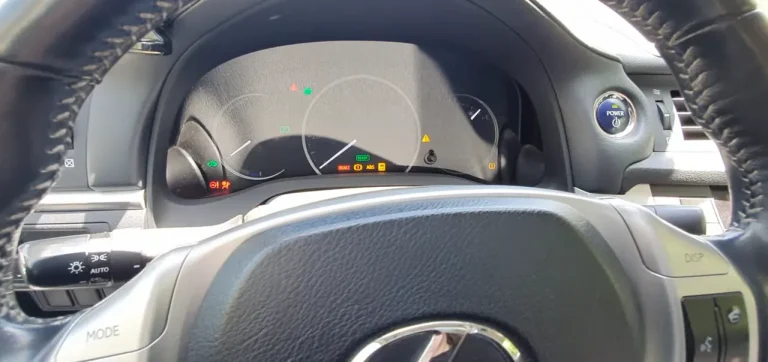Signs of a Bad Intake Air Temp Sensor And Fix It
A malfunctioning Intake Air Temperature (IAT) sensor can lead to various issues affecting engine performance. One prominent sign of a bad IAT sensor is poor engine performance and reduced fuel efficiency. When the sensor fails, it may provide incorrect temperature readings to the engine control module, leading to improper air-fuel mixture adjustments.
This can result in rough idling, sluggish acceleration, and overall diminished power. Additionally, a faulty IAT sensor may trigger the check engine light on the vehicle’s dashboard. Monitoring these symptoms and addressing any issues promptly through sensor replacement can help restore proper engine function and fuel efficiency.
What’s an Intake Air Temp Sensor?
The Intake Air Temperature (IAT) sensor is a crucial component in a vehicle’s engine management system. Located in the intake manifold or air intake system, the IAT sensor measures the temperature of the incoming air before it enters the engine.
The sensor provides this temperature data to the engine control module (ECM) or engine control unit (ECU), which uses the information to adjust the air-fuel mixture for combustion. The IAT sensor plays a vital role in ensuring optimal engine performance, as the density of the air entering the engine varies with temperature.
By accurately monitoring the air temperature, the IAT sensor helps the ECM make real-time adjustments to optimize combustion efficiency, fuel economy, and emissions. Issues with the IAT sensor can lead to incorrect air-fuel ratios, affecting engine performance and fuel efficiency.
How Does an Intake Air Temp Sensor Work?
The Intake Air Temperature (IAT) sensor operates by measuring the temperature of the air entering the engine. Typically located in the intake manifold or air intake system, the sensor consists of a thermistor—a resistor whose electrical resistance changes with temperature.
As the temperature of the incoming air fluctuates, the resistance of the thermistor changes accordingly. The IAT sensor is connected to the engine control module (ECM) or engine control unit (ECU), which reads the varying resistance and interprets it as the air temperature.
This temperature data is crucial for the ECM to calculate the appropriate air-fuel mixture for combustion. In colder temperatures, the ECM adjusts the mixture to ensure efficient combustion, while in warmer conditions, a different ratio is maintained.
The accurate feedback from the IAT sensor allows the engine management system to optimize performance, fuel efficiency, and emissions under various operating conditions, contributing to the overall efficiency and health of the engine.
Signs of a Bad Intake Air Temp (IAT) Sensor
Poor Engine Performance
A malfunctioning Intake Air Temperature (IAT) sensor can lead to poor engine performance. Incorrect temperature readings may cause the engine control module (ECM) to adjust the air-fuel mixture improperly, resulting in rough idling, hesitation during acceleration, or overall reduced power.
Decreased Fuel Efficiency
An IAT sensor providing inaccurate temperature data can affect the fuel-air ratio, leading to decreased fuel efficiency. This may result in lower miles per gallon (MPG) and increased fuel consumption.
Check Engine Light Activation
A failing IAT sensor can trigger the vehicle’s onboard diagnostics system, causing the check engine light to illuminate on the dashboard. Retrieving diagnostic trouble codes (DTCs) can help pinpoint the issue.
Engine Stalling or Surging
Inconsistent or incorrect temperature readings from the IAT sensor may cause the engine to stall or surge unexpectedly. These irregularities can disrupt the engine’s normal operating rhythm.
Difficulty Starting the Engine
A malfunctioning IAT sensor can lead to starting difficulties, especially in extreme temperatures. Incorrect air-fuel mixtures may hinder the engine from starting promptly.
Increased Emissions
If the IAT sensor fails, it can contribute to higher emissions due to improper combustion. This may result in the vehicle not meeting emission standards during inspections.
Acceleration Issues
An IAT sensor providing inaccurate temperature data can lead to poor throttle response and acceleration issues. The engine may feel sluggish or unresponsive when the driver presses the accelerator pedal.
How to Fix a Bad Intake Air Temp (IAT) Sensor?
Fixing a bad Intake Air Temperature (IAT) sensor typically involves replacing the faulty sensor. Here’s a step-by-step guide on how to address this issue:
Diagnosis: Confirm that the IAT sensor is indeed malfunctioning by checking for symptoms such as poor engine performance, decreased fuel efficiency, and activation of the check engine light.
Locate the IAT Sensor: Identify the IAT sensor’s location in the intake manifold or air intake system. Refer to your vehicle’s service manual if needed.
Disconnect the Battery: For safety, disconnect the vehicle’s battery to prevent electrical mishaps during the replacement process.
Remove the Old Sensor: Use the appropriate tools to disconnect the electrical connector from the existing IAT sensor. Remove the sensor from its mounting location, usually by unscrewing it.
Install the New Sensor: Insert the new IAT sensor into the mounting location and secure it in place. Connect the electrical connector to the new sensor.
Reconnect the Battery: Reconnect the vehicle’s battery.
Clear Error Codes: If the check engine light was triggered by the faulty IAT sensor, use an OBD-II scanner to clear any error codes stored in the engine control unit.
Test the Vehicle: Start the engine and test the vehicle to ensure proper engine performance, throttle response, and fuel efficiency. Monitor for any signs of improvement in the symptoms that led to the sensor replacement.
How to Replace Air Filter?
Replacing the air filter is a straightforward maintenance task that contributes to the overall health and performance of a vehicle. To replace the air filter, start by locating the air filter housing, which is typically situated near the engine.
Open the housing and carefully remove the old air filter. Inspect the old filter for dirt, debris, or damage as it can provide insights into the condition of the air intake system. Before installing the new air filter, ensure the housing and surrounding area are clean.
Insert the new air filter into the housing, making sure it sits securely and properly aligns with the housing’s edges. Close the housing and secure any clips or screws. Regular air filter replacement is essential for maintaining proper airflow to the engine, optimizing fuel efficiency, and prolonging the life of engine components.
Refer to your vehicle’s manual for specific instructions and recommended replacement intervals based on your driving conditions.
Can a Bad Intake Air Temp Sensor Damage My Car?
While a bad Intake Air Temperature (IAT) sensor itself may not directly damage your car, it can have adverse effects on the engine’s performance and overall efficiency. The IAT sensor plays a crucial role in providing the engine control module (ECM) with accurate temperature data to adjust the air-fuel mixture.
If the sensor is malfunctioning, it can lead to incorrect fuel delivery, impacting combustion efficiency and potentially causing issues such as poor acceleration, rough idling, and decreased fuel efficiency.
Prolonged operation with a faulty IAT sensor may contribute to increased wear on engine components and may lead to higher emissions. Additionally, continued use without addressing the problem can potentially result in other related issues over time.
Therefore, while a bad IAT sensor might not directly cause physical damage, it is advisable to address the issue promptly to maintain optimal engine performance and prevent potential long-term effects on the vehicle.
What happens when your intake air temperature sensor goes bad?
When the intake air temperature (IAT) sensor goes bad, it can have noticeable consequences on the vehicle’s performance. The IAT sensor is crucial for providing the engine control module (ECM) with accurate information about the temperature of the incoming air.
If the sensor malfunctions or fails, it can lead to a variety of issues. Incorrect temperature readings can cause the ECM to miscalculate the air-fuel mixture, leading to poor engine performance. Symptoms of a bad IAT sensor include poor acceleration, rough idling, decreased fuel efficiency, and potentially an illuminated check engine light.
Inaccurate temperature data can also affect the engine’s ability to adjust to changes in operating conditions, impacting overall responsiveness. Addressing a faulty IAT sensor promptly by replacement is crucial to restore proper engine function, optimize fuel efficiency, and prevent potential long-term effects on the vehicle’s performance. Regular diagnostic checks and maintenance contribute to the early detection and resolution of such sensor issues.
How do you test an air intake temp sensor?
Testing an air intake temperature (IAT) sensor can be done using a multimeter to measure its electrical resistance or voltage. First, locate the IAT sensor, usually positioned in the intake manifold or air intake duct. With the engine turned off, disconnect the electrical connector from the IAT sensor.
If your vehicle has a traditional IAT sensor with a thermistor, set the multimeter to the resistance (ohms) setting. Place the multimeter probes on the sensor’s terminals and measure the resistance. Refer to your vehicle’s service manual for the specific resistance values corresponding to different temperatures. If the readings deviate significantly from the specified values, the IAT sensor may be faulty.
For vehicles with IAT sensors that provide voltage signals, set the multimeter to the voltage setting. Connect the probes to the IAT sensor terminals and turn the ignition to the “on” position without starting the engine. Again, consult the service manual for the expected voltage values at different temperatures. Inconsistent or incorrect voltage readings may indicate a malfunctioning IAT sensor.
FAQ:
Q: What are the signs of a bad intake air temp (IAT) sensor?
A: Signs of a faulty IAT sensor include poor engine performance, decreased fuel efficiency, erratic idling, and potential activation of the check engine light.
Q: Can a bad IAT sensor cause poor acceleration?
A: Yes, a malfunctioning IAT sensor can disrupt the air-fuel mixture, leading to poor acceleration and sluggish throttle response.
Q: Does a faulty IAT sensor affect fuel efficiency?
A: Absolutely. Incorrect temperature readings can lead to improper fuel delivery, resulting in decreased fuel efficiency and increased consumption.
Q: Can a bad IAT sensor cause rough idling?
A: Yes, a malfunctioning IAT sensor can contribute to rough idling as it disrupts the engine’s ability to maintain a stable idle speed.
Q: Will a bad IAT sensor trigger the check engine light?
A: Yes, a faulty IAT sensor can activate the check engine light due to the inaccurate temperature readings affecting the engine control module.
Q: Can a malfunctioning IAT sensor cause engine stalling?
A: Yes, inconsistent temperature data from a bad IAT sensor may lead to engine stalling or irregular engine behavior.
Q: Does a bad IAT sensor affect throttle response?
A: Absolutely. Throttle response may be compromised as the IAT sensor plays a key role in adjusting the air-fuel mixture for combustion.
Q: How does a bad IAT sensor impact overall engine performance?
A: A malfunctioning IAT sensor can result in overall poor engine performance, including reduced power, hesitation, and increased emissions.
Q: Can a faulty IAT sensor cause starting problems?
A: Yes, a bad IAT sensor can contribute to difficulties starting the engine, especially in extreme temperature conditions.
Q: Can a dirty IAT sensor exhibit similar symptoms to a faulty one?
A: Yes, a dirty IAT sensor can cause similar symptoms. Regular cleaning and maintenance are essential to ensure accurate sensor readings and optimal engine performance.
- Why Are My Car Headlights Not Bright Enough? - May 9, 2024
- How Long Can You Drive With An EVAP Leak? - May 9, 2024
- What Does B Stand for in a Car? [Full Guide] - May 9, 2024


